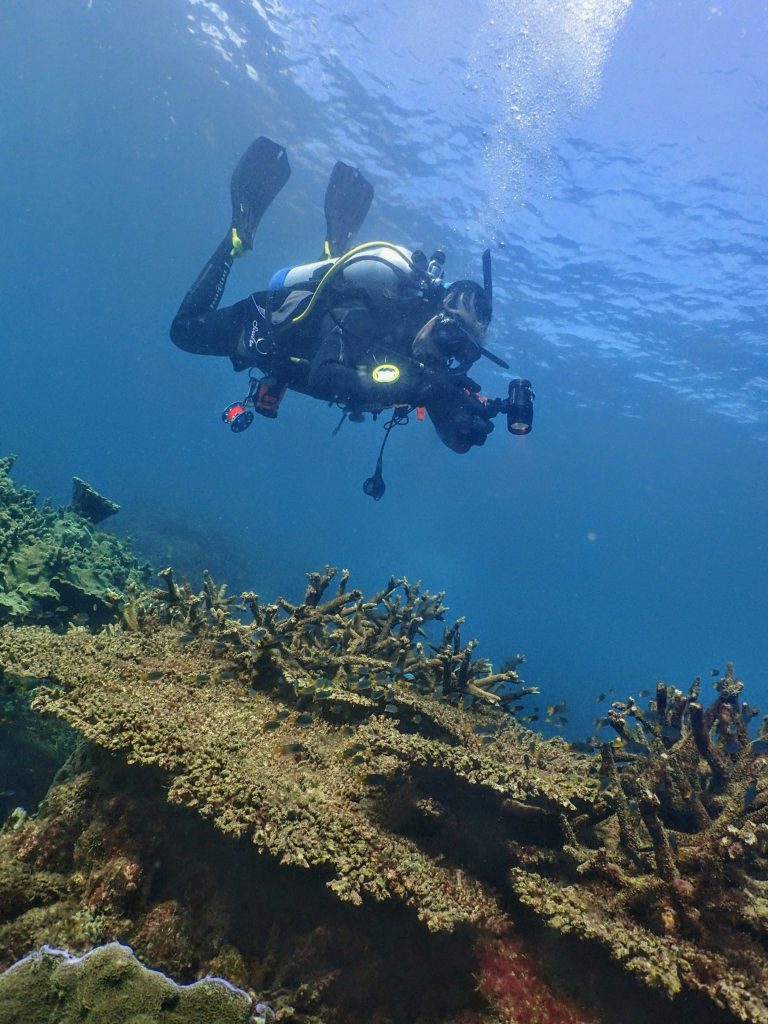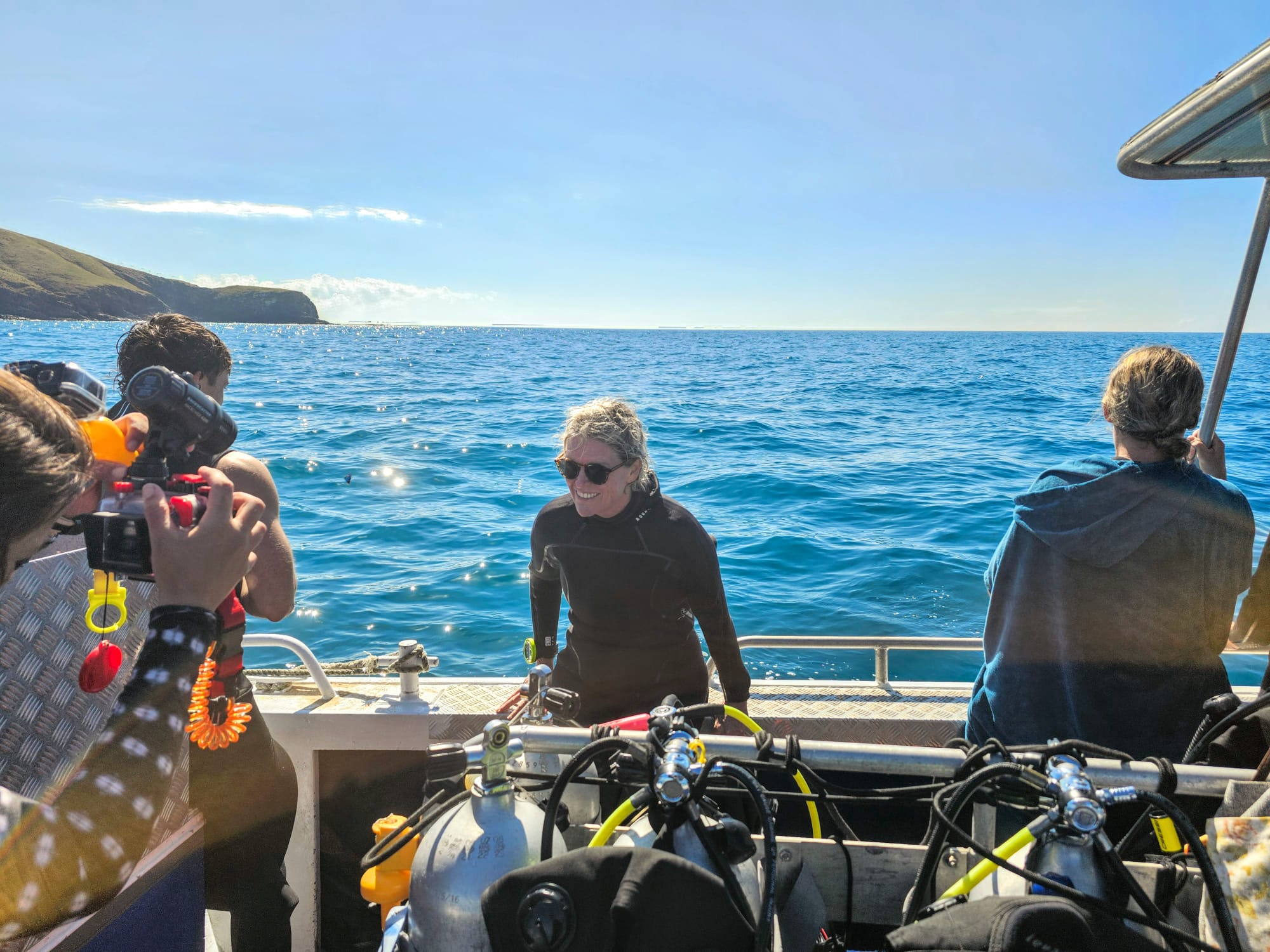I am two dives behind, in explaining the collapse of some of the fields of Acropora spp. across the bay, at the Keppel Islands. And I am off again today, diving.
There have been phone calls, some about the Underwater Megafauna Competition, and others from those complaining about what I write – though they have never got underwater themselves.
She phoned me, yesterday, and was insisting that if I believe that John Brewer Reef will recover from cyclone Kirrily, why have I made such a fuss about the cyclone damage. (I have a blog post about the damage from Tropical Cyclone Kirrily, that I wrote immediately after I visited, CLICK HERE. )
She did not want to acknowledge that many coral reefs up and down the Queensland coast are suffering right now, if not from cyclone damage from coral bleaching. The visibility is still good, particularly at this time of year and there is still so much coral but compared to last year – there has been a collapse in coral cover at some key reef habitats across the northern, central and central Great Barrier Reef. It is a natural cycle.
I explained to her that if we are to understand the different natural phenomena that impact coral reefs sometimes very subtly, then we need to acknowledge the big and sometimes devastating events and accurately record them. I suggested that some of these may follow natural cycles, and that to be possible to forecast these cycles, first we need to have some record of them, and their impacts.
And I reiterated that it was unacceptable that the Australian Institute of Marine Science (AIMS) Long Term Monitoring Program (LTMP) that had recently undertaken yet another perimeter survey of John Brewer Reef, that the official record falsely indicated no change in coral cover since the cyclone.
The survey method was clearly not fit for purpose. Despite so much of the top of this reef being pummelled clean of coral by the cyclone, and whole sections of new growth including the massive plates that once overhung a wide crevasse being picked-up, flipped-over and now laying shattered about the reef perimeter – officially there is no record of this, that officially there has been no change in coral cover. (I also have a blog post about this, how the official survey is a perimeter survey denying damage to key habitats, CLICK HERE.)
She was not from the right of politics not sceptical of catastrophic human-caused global warming at all – rather she is from the left, and so wants to attribute any damage at the Great Barrier Reef to global warming. She wants me to acknowledge that any damage is incremental year-on-year that it is occurring slowly.
‘Did I deny this?’ she asked?
‘It is not incremental,’ I replied. ‘Rather it is cyclical I suggested. The bleaching at the bay across from where I live – at the Keppel Islands – the bleaching is catastrophic. We are fast approaching a total collapse in some fields of Acoropora spp. at places like Wreck Beach – wrecked,’ I suggested.
‘How do you know this is not attributable to fossil fuel emissions?’ she asked.
I said, ‘It was more likely a consequence of the 18.6-year lunar declination cycle that will affect sea levels and the tides.’
I went on to explain that water temperatures may remain below the regional threshold for bleaching, but in places where wave action is insignificant 40 to 75 percent of the coral heads may bleach and go on to die. This was widely reported following the 2006 bleaching – 18.6 years ago, the last summer of maximum lunar declination. Wave-washed sites, they are less likely to suffer damage, I explained.
She hung up. I think that was before I asked her to come diving with me.



 Jennifer Marohasy BSc PhD is a critical thinker with expertise in the scientific method.
Jennifer Marohasy BSc PhD is a critical thinker with expertise in the scientific method.

‘How do you know this is not attributable to fossil fuel emissions?’ she asked.
Surely the question to her is how on earth do you know that it is attributable to fossil fuels?
@David Johnson. How on earth do you know that it is not attributable to fossil fuels?
There are many well grounded reasons why fossil fuels are not the problem and nor is CO2 and they have been patiently explained by Jennifer many times but some people just like to cause trouble and avoid providing their own reasoning – usually a sign that they actually do not know but are pandering to a political cause that may have very little to do with the environment.
There is a very simple solution to this silly dispute. Anyone who insists that fossil fuels are a wicked invention and should be abandoned immediately should put their money where their mouth is and refuse to have anything to do with any product of fossil fuels. Show us how it is done. Good luck eking out a sad life in a mud hut cut off from all communication, all medical care, all transport (where would you go anyway?) and the rest.
I support Peter Etherington-Smith’s comment above. I also find that people who love to self flagellate re our use of fossil fuels usually cannot provide any evidence in support of their hysterical claims. Nor do they seem
likely to totally give up using any of the myriad of products we use daily that are based on fossil fuels. Jennifer, you are a champion of evidence-based truth. Don’t let the morons defeat you.
Peter Etherington-Smith, given your extensive education and career in the petroleum industry, do you think it is possible that you are pandering to an industry cause that may have very little to do with the environment?
The purpose of these reports by Jennifer is to share her knowledge in the hope that readers will be better informed, especially those who do not have the opportunity to experience first-hand what she does. The opportunity is afforded to readers to respond with useful contributions and inquisitiveness, but too much time is taken up by those who denigrate her efforts so I shall not bother continuing on that sterile path.
Whilst Jennifer was reporting on some less than helpful telephone calls she received, that was not the only matter of interest and her observations on the cyclone debris also deserve some comment.
AIMS has proven to be quite spectacularly wrong and incompetent at even basic tasks. One would have expected them to jump at the opportunity to discuss the potential consequences of the cyclone and, were they a bona-fide scientific research institute without a pre-determined mandate to ascribe any damage to climate change, they might have explained the value of the cyclone in re-generation, re-growth and resilience. It may have escaped their attention that cyclones and storms that create coral rubble are amongst the most important means by which coral atolls grow and expand the land area of tropical islands. Rubble is washed up onto reef tops and sides and new coral then grows, especially as sea levels rise, as they have done for most of the last 15,000 years, notwithstanding the periodic falls that have produced some of the calcified reef tops such as Pixie Reef. That is how these islands and lesser reef complexes have coped with ca. 140m rise in sea levels. They did not start out sitting 140m up in the air. So, as is normal, from the debris of recent destruction comes the potential and thrill of new growth that should temper any dismay.
https://www.aims.gov.au/sites/default/files/2020-01/AIMS%20LTMP%20SOP9v4_Crown-of-thorns%20starfish%20and%20coral%20surveys%20using%20the%20manta%20tow%20and%20scuba%20search%20techniques_2019.pdf
I’ve been thinking about Jenn’s denigration of AIMS surveys. There’s is a lot of support for Jenn’s individual, localised, qualitative commentary on the state of the reef. This got me wondering how Jenn’s claims will add value to the long-term state of the reef. Surveys need to be qualitative and comparative over time, especially Long Term Surveys. Otherwise they are just one person’s snapshot and add little scientific value.